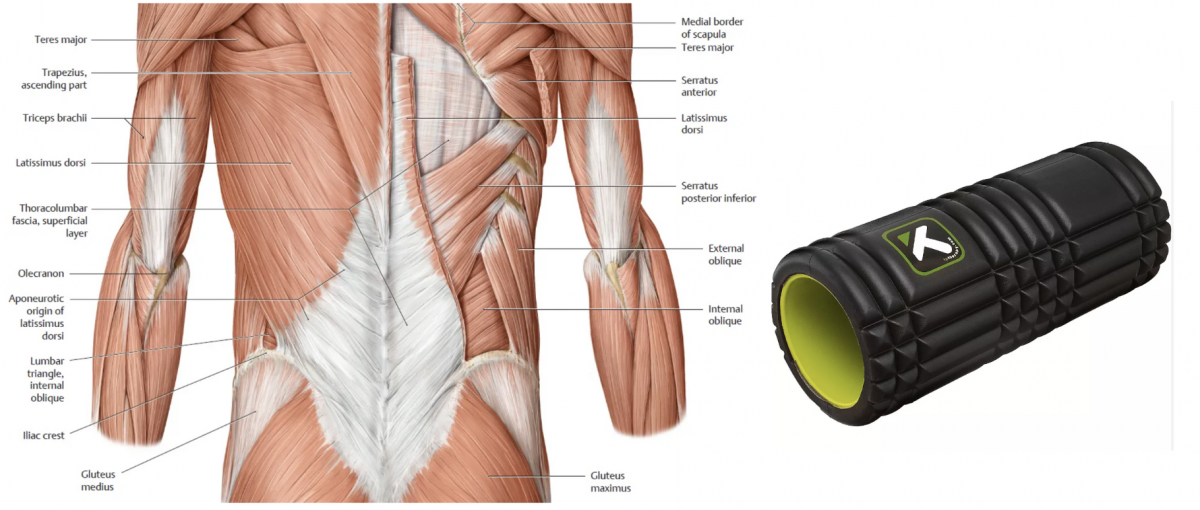Table of Contents
Introduction
Let's start by defining commonly used terms, this groundwork allows us to examine the claimed effects of specific interventions — in this case, foam rolling or massage therapy.
We'll explore whether these treatments or tools are supported by the body of experimental or large prospective data (i.e., scientific studies) available, demonstrating a causal effect or, at the very least, a strong association with the outcomes we find relevant.
Without further ado, let's get started!
Definitions
What is 'Fascia'?
According to the Fascia Nomenclature Committee (FNS) of the Fascia Research Society,
A fascia is a sheath, a sheet, or any other dissectible aggregations of connective tissue that forms beneath the skin to attach, enclose, and separate muscles and other internal organs
Fascia Research Society

If that wasn't complicated enough, there's also an over-arching term that describes fascia throughout the body, known as 'the fascial system'.
"The fascial system consists of the three-dimensional continuum of soft, collagen-containing, loose and dense fibrous connective tissues that permeate the body. The fascial system surrounds, interweaves between, and interpenetrates all organs, muscles, bones, and nerve fibers, endowing the body with a functional structure, and providing an environment that enables all body systems to operate in an integrated manner."
Fascia Research Society
Furthermore, they can be classified in relation to their anatomical position. They are as follows:
- Superficial fascia, usually found directly under the skin
- Deep Fascia, which surrounds bones, muscles, nerves, and blood vessels, and can be further divided into
- Aponeurotic fascia, like the thoracolumbar fascia located at the lower back
- Epimysial Fascia, which envelops muscles such as the pectoralis major and trapezius
- Visceral Fascia, surrounds the lungs, abdomen, and heart.
- Parietal fascia,
To put it simply, it is a continuous 3D matrix of fibrous tissue that spans from head to toe. It consists of proteins that serve as the architectural framework for the body's soft tissues. This intricate fascial network permeates every aspect of the body, entwined with muscles, bones, nerves, arteries, and veins.
What role does it play in our body? According to researchers, It plays a crucial role in connecting various muscles, facilitating their coordinated action in generating stability and skeletal movement via the tendon. Beyond the musculoskeletal system, fascia extends to organs and viscera, enveloping and securely anchoring them within the body's cavity.
To draw an analogy, envision biting into a juicy orange wedge, with each pod neatly encased—we share a similar interconnectedness within our bodies!

Massage Therapy
It is a common misconception that massage therapy only involves lying down on a plinth/bed where the masseuse, sports massage therapist, or (insert title here) kneads, and 'releases' your muscles with his/her bare hands and legs (or even using a tool such as the one below, fancifully termed as instrument-assisted soft tissue massage). In view of this, it's appropriate that we set the foundation for the next few sections of this article.
In the sports science and physiotherapy literature, massage is classified under manual therapy, as previously written here. Therefore, this includes the beloved massage gun, foam roller, lacrosse ball, or the latest contraption on the market (If you know a product that promised extraordinary effects not mentioned here, just drop me a comment below and I'll write a short piece about its claims).
All of these treatment modalities have similar effects - in that they modulate pain through local and central mechanisms, now what does that mean? Refer to this article, and skim over to the section titled 'Biological Mechanisms of Manual Therapy'
Pain can be modulated through upstream methods locally at the level of the spinal cord. However, there are also downstream methods by which the brain modulates the amount of pain you feel, which are contributed by social, and psychological factors.
What is 'Foam-Rolling'?
As mentioned in the preceding section, foam rolling, in my view, can be grouped under the broader category of 'massage therapy.' This is primarily because it offers a similar analgesic (pain-relieving) effect and aids in post-exercise recovery, which I believe is a common reason for its usage. I will delve into this in more detail in the myths section below.
The foam roller has become a common sight in many gyms and fitness studios, and it's been more than a decade since it was initially popularized by Mosh Feldenkrais, an Israeli physicist and martial artist.
Since then, the foam roller has gained popularity and offers a wide range of significant benefits, including improved mobility and flexibility, enhanced recovery, and reduced muscle pain. Feldenkrais was enthusiastic about the foam roller's ability to "release tissue adhesion and improve muscle length".
The latter has been discussed extensively in my previous article on stretching, so I wouldn't elaborate on it further. The former, on the other hand, is a bit tricky to explain, mainly because our tissues (mainly referring to muscle here) can't biologically form an adhesion onto themselves. Still, muscular sore spots are clearly experienced by many and are a known clinical phenomenon.
On the other hand, what exactly causes these sore spots is still poorly understood.
In general, foam rolling can be categorized into two types: "pre-rolling," which is incorporated into warm-up routines, and "post-rolling," used as a recovery tool.
Briefly, however, results from the higher-quality studies have shown marginal benefits before and after workouts, and some of these benefits could be also attributed to the placebo effect.
However, have these suggested hypotheses been proven?
Read on to find out.
Myths of foam-rolling
#1. Foam rolling or rolling a lacrosse ball hard against your legs helps make the muscles more flexible/supple, preparing you for the workout
This is most likely attributed to a reduction in muscular tension through neuronal mechanisms and not an anatomical change in tissue length.
#2. Foam rolling helps to release trigger points, knots, or fascia
As mentioned above, there is no doubt that the phenomenon of "sore spots" exists. However, the assumption that simply rolling would get rid of these spots is rather far-fetched given that human fascia requires large amounts of force to deform even slightly.
#3. Foam rolling helps with recovery post-workout
A meta-analysis in 2019 by Thimo Wiewelhove and colleagues concluded that overall, the effects of foam rolling on performance and recovery are rather minor and partly negligible. If it is of to be any use, however, it should be used as part of a warm-up routine instead.
If not Foam-Rolling, what do?
Given that the most common barrier to regular exercise is the lack of time, the most bang for your buck in terms of health benefits to time invested is simply — strength training and zone 2 (and the occasional zone 4/5) cardiovascular work.
-> I will expand more on the metabolic benefits of Zone 2 Cardio in the next post!
Hope you learned something from this piece! You can help me by:
1) Sharing this article with friends and family, if you think it'll help them. Links to share this article on social media channels can be found below
2) If you feel that my content is inaccurate, misleading, or outdated. Please leave a comment below the article in question.

Marcus Oon
Marcus is a practicing physical therapist and strength & conditioning specialist located in Singapore. He completed his Undergraduate (Hons) degree at the Singapore Institute Of Technology - Trinity College Dublin, and his Strength & Conditioning certification at the National Strength & Conditioning Association (NSCA). He is also active in the NSCA's Health and Wellness, Powerlifting, and Sports Medicine/Rehabilitation Special Interest Groups.
Found this article informative?


